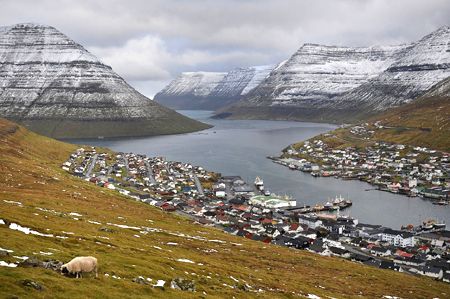by Larry
August, 2017Immigrants Welcome!While the U.S. and many other nations are greatly restricting the number of refugees they will accept, the Faroe Islands are going out of their way to encourage immigration, including among refugees, though for approval to immigrate they must go through Denmark, as the islands, even if an autonomous country, are within the Danish Kingdom. The Faroe Islands archipelago lies about halfway between Scotland and Iceland. Just this year it has achieved a long held goal of raising its population above 50,000. Its economy previously relied heavily on only two industries, sheepherding and fishing or whaling, and at times this has meant a volatile labor market. Lately the unemployment rate is extremely low, though, a bit less than 2%. To look at photos or videos of this tiny state one might not guess it, for the place is rugged, wet, windy, and cold, but the Faroe Islanders are rated as among the happiest people on Earth. The Faroe Islands have an area of 541 square miles. The largest towns are Torshavn (pop. about 13,000) and Klaksvik (pop. about 5000). Despite its northern latitude, temperatures average above freezing year round, thanks to the Gulf Stream. Education is considered good, mostly free, and funded by the government. In the Faroe Islands higher education is available through the undergrad level. Students who wish graduate degrees need to go abroad, mainly to Denmark. Faroe Islanders' health care is also considered good and is mostly free.
Most of the new female arrivals, hundreds in fact, have come from Thailand and the Philippines. Both countries have quite different climates and cultures from the Faroe Islands, so it is a major adjustment for the newcomers. The local language is also not easy to learn. Nonetheless, even if the transition has been challenging for them, most are managing well. One immigrant woman of a few years ago, married now to a Faroe Islander, and they with their son living adjacent a beautiful fiord where the boy can daily play at the beach, when asked if she would not prefer to move into the nearby town where she can associate with more women from her home country, said no, that her rural circumstances are good, she loves her husband and son, and they live in a gorgeous setting, all the surrounding landscape to treat as their own. What is the future like for the Faroe Islands? In some ways things may remain much the same, yet change is also coming. An as yet small but rising immigrant culture is enlivening the towns. Shops and restaurants cater to the newcomers and, in turn, offer more diversity of attire, cuisine, and entertainment for the more dominant, if stodgy portion of society. Some added liberalism is creeping in as well. Same sex marriages were recently accepted. And here too, as on the European continent, the aquaculture, digital, and energy revolutions have been mixing things up, allowing new economic niches to arise. Today, maritime vessels stop at Faroe Island ports enabling thriving commerce. Renewable energy, especially from wind, helps the Faroe Islands get over half their power from renewable sources. On a per capita basis, the abundant fish farming, financial services, IT, telecommunication, and creative arts ventures are transforming a sleepy Faroe Islands economy into one of the more vibrant business and employment spheres available in the developed world. If global warming progresses more swiftly than anticipated, the Faroe Islands could in a few years be dramatically altered. Sea level rise might put their fishing communities at risk, and Greenland's melting ice sheets, adding abundant fresh water to the salty Gulf Stream's flow, could reduce or halt that sea river's warming influence, ironically threatening the islanders with more severe winters. |
